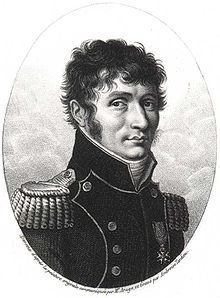Louis Malus
Étienne Louis Malus (born June 23, 1775 in Paris ; † February 23, 1812 there ) was a French engineer and physicist .
Life
Louis Malus was the son of Anne-Louis Malus du Mitry and Louise-Charlotte Desboves. His father was the treasurer. Malus' mathematical talent was already evident at school, which he had to leave for political reasons in 1793 ( French Revolution from 1789 to 1799). As a result, Malus was brought up almost exclusively privately, mainly in Greek, Latin and mathematics. He revealed his math skills in 1793 while taking the entrance exam to the military school in Mézières . Malus served as a simple soldier until 1794 when he was sent to the École polytechnique . There he was a student of Joseph Fourier (1768-1830). He became a second lieutenant of engineers on February 20, 1796 and captain of engineers on June 19, 1796, took part in Napoleon Bonaparte's Egyptian expedition and served as a soldier in Syria from 1798 to 1801.
Before that, Malus was stationed in Gießen in 1797 and wanted to marry the eldest daughter of the Chancellor of the University Wilhelmine-Louise Koch shortly before he left for Egypt. He was only able to realize this marriage after his return in 1801. She died on August 18, 1813.
Malus survived an infection in Egypt and landed in Marseille on October 14, 1801. From 1802 to 1803 he worked in Lille and as a sub-director for the fortifications of Antwerp (1804-1806) and Strasbourg (1806-1808). In 1808 Malus went to Paris, where he was appointed mayor of engineers on December 5, 1810. From July 1807 he was a member of the Société d'Arcueil
In 1810 he was accepted into the French Academy of Sciences . In 1811 Malus was part of the award committee for the best description of heat propagation in solids , which Fourier received, together with Joseph-Louis Lagrange , Adrien-Marie Legendre , Pierre-Simon Laplace and René-Just Haüy .
His name is immortalized on the Eiffel Tower, see: The 72 names on the Eiffel Tower . In addition, the island of Malus Island in Antarctica bears his name.
Scientific achievement
His research began with experiments on Huygens' refraction and systematic investigation of the properties of surfaces with regard to reflection and refraction .
Malus found out in 1809 that light is partially linearly polarized when it is reflected . H. the light waves oscillate in one plane. This subsequently led to a better understanding of the propagation of light. The dependence of the intensity of polarized light on the alignment of a polarized filter (= analyzer) is called Malus ' law.
In another publication in 1810, Malus wrote about the birefringence of light in crystals.
Fonts (selection)
- Mémoire sur la mesure du pouvoir réfringent des corps opaques . in Nouveau bulletin des sciences de la Société philomathique de Paris, 1 (1807), 77–81
- Mémoire sur de nouveaux phenomena d'optique . ibid., 2 (1811), 291-295
- Traité d'optique . in Mémoires présentés à l'Institut des sciences par divers savants, 2 (1811), 214–302
- Théorie de la double refraction de la lumière in the substances crystallines . ibid., 303-508
literature
- Kahr, Bart; Claborn, Kacey: (2008) The lives of Malus and his bicentennial law. Chemphyschem: a European journal of chemical physics and physical chemistry 9 (1): 43–58, 2008 Jan 11
Individual evidence
- ^ Encyclopedia.com: Etienne Louis Malus - Facts, information, pictures
Web links
| personal data | |
|---|---|
| SURNAME | Malus, Louis |
| ALTERNATIVE NAMES | Malus, Étienne Louis |
| BRIEF DESCRIPTION | French engineer and physicist |
| DATE OF BIRTH | June 23, 1775 |
| PLACE OF BIRTH | Paris |
| DATE OF DEATH | February 23, 1812 |
| Place of death | Paris |
